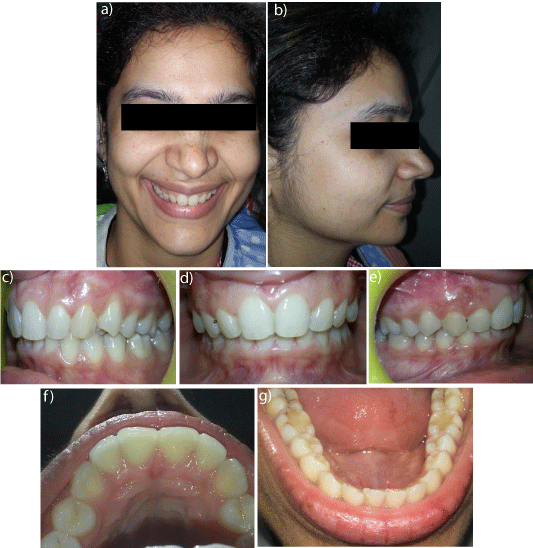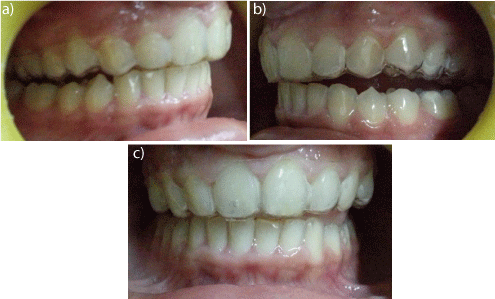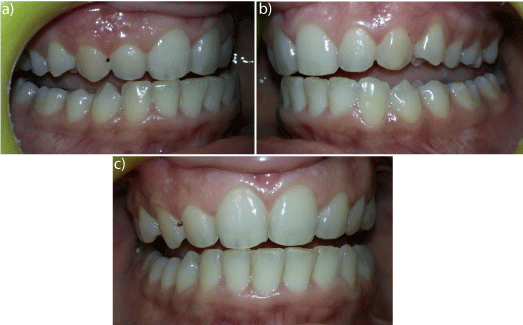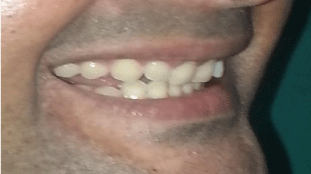
Case Report
J Dent App. 2015;2(5): 219-222.
Constricted Path of Closure: A Diagnostic Challenge
Rakesh Kontham1* and Ujwal Kontham2
1Associate Professor, Department of Orthodontics, Nair Hospital Dental College, Mumbai-400008, Maharashtra, India
2Professor, Department of Pediatric Dentistry, Dr D Y Patil Dental College and Hospital, Pimpri, Pune, Maharashtra, India
*Corresponding author: Rakesh Kontham, Associate Professor, Department of Orthodontics, Nair Hospital Dental College, Mumbai-400008, Maharashtra, India
Received: December 15, 2014; Accepted: March 11, 2015; Published: March 13, 2015
Keywords
Centric relation; Attrition; Constricted path of closure; Deprogrammer
Introduction
Malocclusion prevents uniform contact of teeth during mandibular movements. Occlusal interferences can lead to severe loss of tooth structure and can lead to TMJ disorders. Dental examination must include an evaluation of the occlusion for interferences and signs of wear or instability of the occlusion. The most common types of occlusal wear are [1,2].
True Bruxism (Parafunction)
Occlusal wear triggered by the brain and has no functional purpose.
Occlusal Dysfunction
Occlusal wear triggered by posterior interferences leading to excessive grinding.
Constricted Path of Closure (CPC)
Occlusal wear occurs during closure in maximal intercuspal position (MIP) due to anterior interferences pushing the condyles distal to centric relation (CR) [3].
A distinction between these three types of abnormal occlusal function becomes mandatory for correct treatment planning. It is especially important to diagnose patients with constricted path of closure (CPC) because the mandible needs to move forward into a stable jaw relationship, which in turn can influence the treatment plan dramatically [4-6].
CPC patients include those with deep overbite, steep interincisal angle, under torqued upper anteriors after orthodontic treatment and palatally over contoured anterior restorations. These patients are at a high risk of severely damaging the anterior teeth and restorations. Muscle and TM joint symptoms may develop as these are continually forced to adapt especially in presence of stress or trauma [7-10].
A deprogrammer is a valuable tool for diagnosing CPC cases without any need for elaborate procedures and high –end equipment [11,12].
The following case reports describe the importance of using a deprogrammer in diagnosis, treatment planning and alleviation of symptoms of patients with CPC.
Case 1: Constricted Path of Closure
A 37-year-old female patient reported with reduced mouth opening, a general feeling of tightness in both cheeks and pain on forced opening. The patient had to manipulate the mandible in a downward and forward direction to increase the mouth opening each time she chewed and this was accompanied by a clicking sound in both the joints. When the mandible was brought forward in an edge to edge position the mouth opening returned to normal and the clicking in the joint disappeared.
On clinical examination, a soft end feel was observed with pain on forced mouth opening; however, palpation of the TMJ area did not elicit pain. Mouth opening was reduced to 25mm and the patient had to protrude the mandible to an edge-to-edge position to open the mouth further.
On intraoral examination wear facets were seen on the palatal surfaces of maxillary incisors, incisal and labial surfaces of mandibular incisors (Figures 1f, 1g). A class I molar relationship was seen on both sides and a deep bite (6 mm) was present. Tooth #14 and 24 were in scissor bite. The maxillary incisors were upright (Figures 1c, 1d and 1e). The patient was able to close in a maximal intercuspal position easily and repeatedly (MIP) with no evident deflection.

Figure 1: a and b: Case 1 Extra-oral views. c, d and e: Case 1.Intra-oral
views. f and g: Case 1. Occlusal views.
Cephalometric analysis revealed a mild Class II with horizontal growth pattern. The upper incisors were upright with an increased interincisal angle.
Diagnosis
CPC with Class II disk interference due to heavy contacts in the anterior region forcing the mandible posteriorly [13]. Pain reduced dramatically after 48hrs of deprogrammer wear and mouth opening returned to normal. The centric relation recorded after a week of deprogrammer wear (Figures 2a, 2b and 3a-3c).

Figure 2: a and b: Deprogrammer.

Figure 3: a, b and c: Intra oral views with deprogrammer.
Treatment
As the patient had muscle and jaw symptoms and a typical wear pattern consistent with a constricted path of closure, it was decided to use a deprogrammer. After 48 hours of deprogrammer wear, the patient reported increased mouth opening and a feeling of relief in the muscles. Recording CR after a week gave an edge-to-edge bite confirming a constricted path of closure (CPC) (Figures 4a-4c).

Figure 4: a, b and c: Intra-oral views after deprogramming.
The treatment plan consisted of full bonded fixed appliances to establish the correct torque of upper anteriors and procline them allowing the mandible to come forward in centric relation.
Case 2
A 42-year-old male patient reported with chief complaint of generalized discomfort in both cheeks, inability to chew, sensitivity in the upper anterior teeth and a fractured upper right lateral incisor. The patient was unable to sleep at night and complained of severe fatigue during the daytime.
Extra-oral examination revealed a symmetrical face, convex profile, mildly retruded chin (Figures 5a and 5b). Pain was not elicited on palpation of the TMJ. The mouth opening was limited to 26mm and forced opening elicited pain. The patient had tremors in the muscles of mastication when the mouth is kept open out of occlusion.

Figure 5: a and b: Case 2a and b Extra-oral views. c, d and e: Case 2
Intra-oral views.
Intra-oral examination revealed a bilateral class I molar relationship with 100% deep bite, severe wear on the palatal surfaces of the maxillary incisor, as well as the incisal and labial surfaces of lower incisors (Figures 5c, 5d, and 5e). Tooth # 22 was fractured and did not show evidence of carious involvement (Figures 6a-6c). The posterior teeth did not exhibit severe attrition.

Figure 6: a, b and c: Case 2 Occlusal views.
Diagnosis
CPC with Class II disk interference with heavy contacts in the anterior teeth forcing the mandible posteriorly [13]. The patient was comfortable after 48hrs of wearing the deprogrammer, but the CR was recorded after a week when the patient had become asymptomatic.
Treatment plan
- Endodontic treatment of 22, followed by placement of post and core with temporary restoration.
- Deprogrammer for confirming CPC suspected due to the typical wear pattern (Figure 7) (CR recorded after a week).
- Full bonded fixed appliance for intrusion and proclination of upper incisors thus permitting the mandible to come forward in to centric relation.
- CPC cases should be diagnosed in the early stages as failure to do so might lead to severe wear of anterior teeth, muscle and joint symptoms.
- CPC cases can be diagnosed reliably with a deprogrammer without the need for sophisticated and expensive equipment.
- The symptoms are completely alleviated with 1 week of deprogrammer wear, but if anterior positioning of the condyle is required then atleast 3months of deprogrammer is advocated [7,8,11]. Further treatment to correct the problem involves full bonded appliance to correct the torque of the upper anteriors so as to allow the mandible to come forward in the correct centric relation.
- Patients who require anterior condylar repositioning need to wear an anterior repositioning splint for at least 3 months.
- Jarabak J. ElectromyographicAnalysis of Muscular and TemporomandibularJoint Disturbances Due to Imbalances of Occlusion. Angle Orthod 1956;26:170-190.
- Peter E.Dawson. Why occlusal wear is commonly ignored? 2012; www.The Dawson Academy.com.
- Weinberg LA. Optimum condylar joint position in clinical practice. Int J Periodont Rest Dent1985; 5:10-27.
- Weinberg LA. Correlation of temporomandibular dysfunction with radiographic findings. J ProsthetDent 1972; 28:519-539.
- Weinberg LA. The role of condylar position in TMJ dysfunction pain syndrome.JProsthetDent1979;41:636-643.
- Weinberg LA,Lager L. Clinical report on the etiology and diagnosis of TMJ dysfunction pain syndrome.J ProsthetDent1980;44:642-653.
- Weinberg LA. Posterior bilateral displacement: Its diagnosis and treatment. J Prosthet Dent1976;36:426-440.
- Weinberg LA. Posterior unilateral condylar displacement: its diagnosis and treatment. J Prosthet Dent1977;37:559-569.
- Weinberg LA. Anterior condylar displacement: Its diagnosis and treatment. J Prosthet Dent1975;34:195-207.
- ReiderC, MartinoffJ. The prevalence of mandibular dysfunction. Part II:A multiphasic dysfunction profile.J Prosthet Dent 1983; 50:237-244.
- Don Jayne A. Deprogrammer for Occlusal analysis and simplified accuratecase mounting. Journal of cosmetic dentistry winter 2006; 21;4:96-102.
- Kontham RK, Kontham UR. Easy fabrication of an occlusal deprogrammer. J ClinOrthod2014; 48; 6:368-370.
- Okeson Clinical management of TMJ problems. 295-296.

Figure 7: After deprogramming.
Discussion
Although not pathognomonic of acute pain dysfunction syndrome, condylar displacement indicates the appropriate method of treatment of the same [7-9]. Acute TMJ pain dysfunction has been correlated with a 90% incidence of condylar displacement [3- 5]. Reider examined 1000 patients over a period of 10 years, and showed a direct relationship between dysfunction and condylar displacement, and conversely demonstrated a direct relationship between condyle concentricity and joint health In these studies, posterior condylar displacement occurred in 53% to 70% of patients with acute pain dysfunction syndrome and a very low incidence of condyle concentricity (3.6%) was found in acute TMJ dysfunction syndrome [10].
Patients with CPC are at a significant risk of developing muscle and joint symptoms as the mandible is continually forced to adapt to a more retrusive position due to heavy occlusal contacts in the anterior region. If this ability to adapt is diminished due to trauma or stress, they run a higher risk of becoming symptomatic. Such patients can develop significant wear facets on the palatal surfaces of maxillary anteriors and incisal and labial surfaces of mandibular anteriors [11].
It is important that the mandible move forward in centric relation in patients with CPC. Proclination of the maxillary anteriors or retraction of the mandibular incisors is essential to facilitate removal of all occlusal interferences [11].
According to Weinberg, 80% of patients with TMJ dysfuncton and CPC respond well to shortening of lower anterior teeth and relieving the lingual surfaces of maxillary anterior teeth, while remaining 20% will require anterior condylar repositioning [5].
Constricted path of closure (CPC) can be easily overlooked by clinician, because such patients are easy to manipulate into CR and often give reproducible mountings. A deprogrammer can ensure accurate diagnosis of CPC cases while obviating the need for expensive equipment [11,12]. To conclude,
References